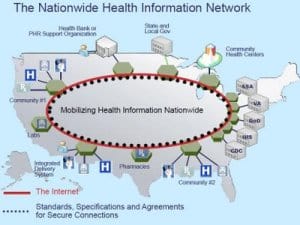
Thankfully, a new administration has come on board, new people have joined ONC and the bloated NHIN of recent history is getting a major rework – actually being split with NHIN referring more to the policy constructs that will define information exchange (the DURSA – Data Use and Reciprocal Support Agreement) and NHIN Direct, a much lighter weight technology stack to enable point to point communication.
Unfortunately, Chilmark has not had the time as of late (see previous post) to do a deep dive but while at the recent Governor’s Conference here in Boston, we bumped into Keith who works for GE and has represented GE in many of the discussions/meetings that ONC has held recently on NHIN and NHIN Direct. Therefore, I asked him if he would be willing to write something on this topic, which follows below. (Note, in conversations with some State Reps at the Governor’s conference, there is some significant consternation among many regarding the NHIN and NHIN Direct so this is far from a slam dunk for the feds – time will tell as to how this will actually be adopted and used.)
And if this topic of standards evolution, healthcare, information exchange interests you, encourage you to follow Keith’s Blog as he has some good stuff there.
What is the NHIN
What is the NHIN, NHIN Connect and NHIN Direct, and the differences between them?
NHIN stands for the National Health Information Network. But NHIN is not really a network, rather, it is a concept describing the infrastructure needed to connect healthcare providers from Maine to California to Alaska to Hawaii to Alabama to …
A better name for NHIN would be the National Health Information Infrastructure, or NHII. At least that’s what we called it in 2004. Some of this is covered in a post I did on the history behind ARRA.
The NHIN has been described as the backbone for exchange, much like the Interstate Highway infrastructure. We really already have the necessary infrastructure needed: that is the Internet. What NHIN really did was specify the rules of the road for traveling on the healthcare interstate.
In 2006, the newly create Office of the National Coordinator issued an RFP to test (pilot) technologies that would be used to connect heatlhcare providers across the states of this country. I’m not sure why, but they used the name NHIN for this program, rather that show continuity with the NHII work that had gone on before. Four organizations were awarded contracts for this NHIN Pilot project.
Subsequently in 2007-2008, a new RFP was issued and awarded by ONC across 11 different healthcare organizations to support NHIN Implementations. The Federal Health architects across the federal agencies realized that they needed a platform to help agencies and organizations to connect to these NHIN implementations. This project was an Open Source software project that became NHIN Connect. NHIN Connect provides the software you need to get on the highway and follow the rules of the road. It’s been called the onramp to the NHIN.
Finally, we have NHIN Direct. To get from my home to my doctor’s office, I never go near the highway. To get from my doctor’s office to one of my specialists, I still need to travel from the office parking lot, to the interstate. I drive differently on these back streets and local highways than I do on the Interstate. The rules are different there. The same is true for the small practice. In order to connect to their collegues and to their paitients, they need a different infrastructure. That infrastructure needs to be sommething that they can purchase from Best Buy, or sign up for over the web, using the stuff they already have, to allow them to connect up to the NHIN. NHIN Direct is the way that providers can connect to others without having to be aware of the gravel, concrete and steel that they are driving over. They just want to get into their car and go.




0 Comments